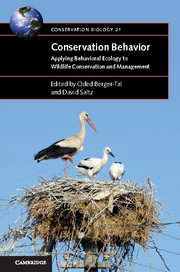Book contents
- Frontmatter
- Dedication
- Contents
- List of contributors
- Prologue
- Preface
- Acknowledgments
- Part I The integration of two disciplines: conservation and behavioral ecology
- Part II Anthropogenic impacts on animal behavior and their implications for conservation and management
- Part III Behavior-based management: using behavioral knowledge to improve conservation and management efforts
- 6 The role of animal sensory perception in behavior-based management
- 7 Behavior-based contributions to reserve design and management
- 8 Behavior-based management: conservation translocations
- 9 From individual behavior to population viability: implications for conservation and management
- 10 Manipulating animal behavior to ensure reintroduction success
- Part IV Behavioral indicators
- Index
- References
7 - Behavior-based contributions to reserve design and management
from Part III - Behavior-based management: using behavioral knowledge to improve conservation and management efforts
Published online by Cambridge University Press: 05 April 2016
- Frontmatter
- Dedication
- Contents
- List of contributors
- Prologue
- Preface
- Acknowledgments
- Part I The integration of two disciplines: conservation and behavioral ecology
- Part II Anthropogenic impacts on animal behavior and their implications for conservation and management
- Part III Behavior-based management: using behavioral knowledge to improve conservation and management efforts
- 6 The role of animal sensory perception in behavior-based management
- 7 Behavior-based contributions to reserve design and management
- 8 Behavior-based management: conservation translocations
- 9 From individual behavior to population viability: implications for conservation and management
- 10 Manipulating animal behavior to ensure reintroduction success
- Part IV Behavioral indicators
- Index
- References
Summary
INTRODUCTION
All students of conservation are familiar with the quintessential model of a reserve network, in which a hostile, human-dominated matrix limits the occurrence of natural habitat and vulnerable species to scattered protected areas connected by corridors of intermediate suitability (e.g. Diamond 1975, Soule & Terborgh 1999, Bennett 2003). This conceptual model also identifies anthropogenic features, such as roads, that may create such significant barriers to animal movement that they require mitigation (reviewed by Forman et al. 2006). The resulting construct for conservation planning tends to categorize types of space as core areas, corridors, matrix and barriers while underestimating the myriad non-spatial features of both species and landscapes that exist along inconvenient and intersecting continua. Behavior is one of these factors and it contributes much to the fate of imperiled populations, but its effects have not been much synthesized in the contexts of reserve design and conservation management.
Before delving into the role of behavior in reserve design, it is worth pausing to consider some of the reasons for the traditional emphasis on spatial characteristics. First, binary and spatial constructs are readily visualized by people to facilitate common and explicit goals, such as the creation of national parks and other kinds of protected areas. Second, spatial features of reserve design are supported by foundational and extensive ecological theory, much of which emanated from Island Biogeography (MacArthur & Wilson 1967, reviewed by Lomolino & Brown 2009), to provide support for conservation predictions, management actions and enduring academic interest. A third reason that spatial attributes lead so much of reserve design is that space influences most of the physical experiences of organisms and defines most anthropogenic threats to biodiversity (Chapter 1) across a vast range of scales.
Despite the good reasons to emphasize space in reserve design, we contend that space alone does not define the experience of any individual or directly imperil populations. Space is more like a canvas on which those experiences play out. Protecting the habitat contained in space is essential to most conservation action, but that action alone cannot ensure the survival of individuals, populations, species or ecosystems. Moreover, spatial attributes are difficult to generalize as both problems and solutions in conservation (Newmark 1996, Gascon et al. 2000), which limits their proactive use in ways that could best advance conservation goals (Caughley 1994).
- Type
- Chapter
- Information
- Conservation BehaviorApplying Behavioral Ecology to Wildlife Conservation and Management, pp. 176 - 211Publisher: Cambridge University PressPrint publication year: 2016
References
- 1
- Cited by

